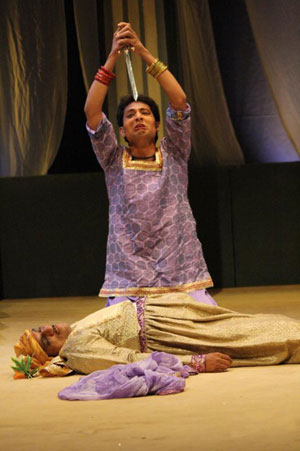A Play on Words
By Maheen Bashir | Arts & Culture | Published 15 years ago
In Pakistan, everybody thinks they know Shakespeare — thanks to the incorporation of Charles and Mary Lamb’s Tales from Shakespeare into the syllabi of all English-medium schools across the country. With brazen confidence, people proclaim, “We know what happens in this play” or that, while all they really know is who the characters are and what the plot is. With the same assurance many translate, adapt and stage Shakespeare plays, churning out a performance that falls flat on its face. But, surprisingly, NAPA’s Beech Bahar ki Raat ka Sapna, based on A Midsummer’s Night Dream, and staged at the Karachi Arts Council from April 2-11, was a success.
Khaled Ahmed must be applauded for his near-perfect Urdu adaptation of the comedy, which impressed even Urdu connoisseurs. This was not NAPA’s first attempt at staging a Shakespearean script — with versions ofKing Lear and Othello preceding it — but it was definitely their best effort yet.
The tale begins with four lovers in turmoil. Taimur desires Hermia, and is also her father’s chosen suitor. But Hermia is in love with Zain ul Abideen and he with her. Then there is Alina, Hermia’s close friend, who is in love with her friend’s suitor. Hermia elopes with her lover to escape Taimur who, enamoured by her beauty, follows after the lovers, with Alina in pursuit. The four follow one another into the enchanted forest, where we are introduced to Gulfaam, king of the elves, and Gulnar, queen of the fairies.
Gulfaam and Gulnar are plagued by their own dilemma. Gulnar is furious with Gulfaam for being jealous over the attention paid by her to the young boy she has adopted. The play takes an interesting turn when Gulfaam decides to get his revenge and Puck, one of his elves, is chosen to do the needful. The arrival of the four lovers into the forest provides Puck with the perfect opportunity to test his grand design: the elf tries a love potion on the unassuming humans that he later intends to use on Gulnar. Oblivious to the conflicts around them are servants of Wali (the Duke of Athens from the original script), rehearsing their lines for the upcoming nuptials of their master. As they struggle to get their act together for the grand occasion, their failure to do so elicits quite a few laughs. From this second set of humans, Puck manages to pull in Painda, to add the final touches to the plan. And then he executes: he turns Painda’s head into that of a donkey’s and makes Gulnar fall in love with him using the potion.
 Mohsin Ali as Puck held the audience captive each time he appeared on stage to execute his devious plans against Gulnar. Haisam Naqvi’s animated act as Murli, one of Wali’s workers, was most entertaining. Of the others, Mehvish Siddique, NAPA alumni, seemed confident and comfortable in her role as the naïve beauty, Hermia. Mehreen Rafi, however, who played Alina, was a little high-pitched and tended to over act. Aimen Tariq, a seasoned actress, played her part as Gulnar gracefully, while Mustafa Afridi portrayed a commanding Gulfaam well, with his voice resonating in the theatre. Despite their good performances though, there was a definite lack of chemistry between the two, which could have added to the act.
Mohsin Ali as Puck held the audience captive each time he appeared on stage to execute his devious plans against Gulnar. Haisam Naqvi’s animated act as Murli, one of Wali’s workers, was most entertaining. Of the others, Mehvish Siddique, NAPA alumni, seemed confident and comfortable in her role as the naïve beauty, Hermia. Mehreen Rafi, however, who played Alina, was a little high-pitched and tended to over act. Aimen Tariq, a seasoned actress, played her part as Gulnar gracefully, while Mustafa Afridi portrayed a commanding Gulfaam well, with his voice resonating in the theatre. Despite their good performances though, there was a definite lack of chemistry between the two, which could have added to the act.
A surprise appearance was the familiar face from television, Chef Shai, who bedazzled in her white, shimmering gown as one of the fairies. The cast of 22 actors, which included many first timers, rehearsed tirelessly for two months straight — and it showed.
Beech Bahar ki Raat ka Sapna is the first play by NAPA to incorporate live music — even though the live singing and vocals were not Broadway stock. Ustaad Nafees Ahmed Khan, head of the department of music at the institute, contributed his talent to create a background melody, which included traditional instruments like the Sitar.
 Jamil Afridi, who put together a creative and colourful semblance of costumes, wasn’t as successful with the set. While the transition from an urban setting to the forest was smooth, the feel of an enchanted forest just did not come through. The lighting was also rather gloomy, and left the decorations looking drab.
Jamil Afridi, who put together a creative and colourful semblance of costumes, wasn’t as successful with the set. While the transition from an urban setting to the forest was smooth, the feel of an enchanted forest just did not come through. The lighting was also rather gloomy, and left the decorations looking drab.
The usual charge levelled against NAPA, that it caters only to “intellectuals,” came to naught with the frequent laughter of child members of the audience. Even the older female members had to be told several times by the ushers to pitch down their exclamations over Hermia’s fate. And though the play spanned two-and-a half hours, it kept the audience entertained and managed to please all ages.
Maheen Bashir Adamjee is an APNS award-winning journalist. She was an editorial assistant at Newsline from 2010-2011.


